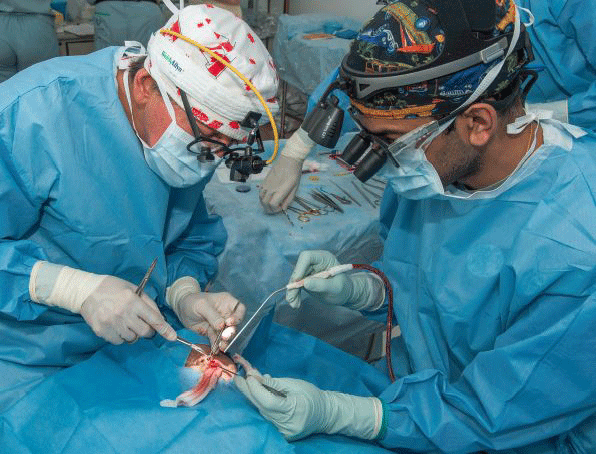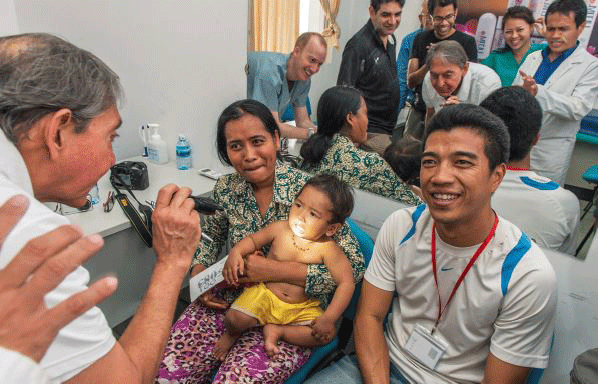Medical contributions to an impoverished community: A great idea realized
Throughout medical school we are emboldened by the idea that, as physicians, we will have the ability to make an incredible difference in the lives of our patients and in the broader community. Whether through research, politics, or not-for-profit organizations, doctors have access to numerous avenues to introduce great change. Some changes may be for the better (such as Dr Semmelweis’s pioneering work with antiseptic procedures[1]), and others may be for the worse (such as Dr Wakefield’s misleading link between vaccinations and autism[2]).
How does one develop a great idea into a fully functioning not-for-profit organization that makes a tangible, positive difference? The founding principles of an organization that I became involved with a few years ago effectively demonstrate how to develop a successful not-for-profit and may be helpful to others interested in following a similar path. Operation Rainbow Canada (ORC) is a Vancouver-based, volunteer-run, not-for-profit medical services organization that travels to developing countries to provide cleft-lip and cleft-palate repairs to children in need. For over 16 years the organization has provided these services free of charge and, in doing so, has changed the lives of countless children. ORC has also recently started developing self-sustaining surgical units that will be equipped to provide these free surgeries throughout the year. ORC plans to train medical professionals local to the affected communities and invest in local equipment to give the communities the tools they need to carry out the surgical repairs themselves, thereby ensuring that they are consistently well supported.
The impact that ORC has had internationally is remarkable, and the story of the organization’s development is inspirational, exemplifying how one person can make a great change. Prior to 1998 ORC was just an idea of Vancouver plastic surgeon Dr Kimit Rai. With support from his friends, colleagues, and community, Dr Rai was able to apply his skills as a surgeon to turn the idea into the vehicle for change that it is today.
Among the many components that make ORC successful, four essential elements stand out:
• A clear goal
• A complementary skill set
• A balanced team
• A supportive community
Set a clear goal
Set a clear, specific, meaningful goal for the organization to focus people’s efforts and attract others who are passionate about the cause. If the goal is not clear, people won’t know exactly what you are trying to achieve and won’t be as willing to support your work, even if they are passionate about the issue. The goal should also be specific enough for you to be able to gauge if it is realistic and achievable but not so niche that it becomes difficult to obtain sufficient support. Most importantly the goal should be meaningful to you. If you are passionate about the organization’s objective it will be much easier to achieve it, and the difficulties that you’ll face along the way will be tempered by your underlying drive to see the changes take place.
Dr Rai defined a clear goal for ORC: the organization was developed to surgically correct cleft-lip and cleft-palate deformities in children in impoverished communities. There is no uncertainty about the organization’s purpose. The goal is also specific, realistic, and relatable. It focuses on a common issue that many individuals can identify.
Bring together a complementary skill set
Part of choosing an effective goal and increasing your chances of achieving it is ensuring that you have the necessary skills in place, whether you develop those skills yourself or partner with someone who already has them. People will be hesitant to become involved and lend support if you cannot assure them that you have the ability to accomplish your goal.
As a practising plastic surgeon, Dr Rai was able to perform the surgical repairs. He was also surrounded by medical professionals with the complementary skills needed to carry out the operations. His clear vision and his expertise allowed him to achieve broad support from many of the doctors and nurses he worked with. Additionally, by structuring the medical missions as unique learning opportunities, he was able to attract interested residents and fellows to join his cause. Alongside this passionate team of experts Dr Rai has performed countless surgeries, and the team has created a solid foundation that attracted support from professionals in other fields and the surrounding community.
Assemble a balanced team
Uniting many different abilities will lead to a better functioning organization. Managing a team, the finances, and public awareness of the organization are a few examples of the roles that may need to be filled by experts from other fields, and you may turn to established contacts or develop new ones to fill these roles.
At ORC, medical professionals are essential to carrying out the cleft-lip and palate repairs; however, many other professionals with backgrounds in business management, finance, and public relations are involved to ensure the organization runs harmoniously. Some are Dr Rai’s long-established friends while others are new contacts introduced by members of the organization. The wide range of insights and expertise assembled in the group allows it to grow quickly and seamlessly, and makes unsolvable problems a rarity. The diversity also provides ORC with an expansive support network, allowing the organization to function with no paid staff—a feat often viewed as impossible for successful not-for-profits.
Grow a supportive community
Although the benefits are not always immediate, the advantages of having the support of one’s community are a definite asset, increasing the likelihood that the organization’s work is preserved and the differences achieved are long lasting. Whether you choose to spread information about the organization via word of mouth or turn to social media for support, the more people that know about the organization the greater the chances that people will talk about it, support it, and want to contribute to it.
For many years ORC’s only sources of support were private donations and word-of-mouth. Over the years the organization’s consistent success and unwavering efforts have attracted support from many other avenues, including numerous businesses and prominent individuals. In 2014 Dr Rai received the Governor General’s Caring Canadian Award for his work with ORC. Additionally, volunteers specializing in multimedia production and public relations have joined ORC and introduced social media as a new publicity tool for the organization.
Conclusion
Through strong leadership, the support of a diversely talented group of individuals, and the backing of the local communities that are affected, ORC has set a clear objective, reached its goals, and is making a significant impact. Anyone who wants to make a difference can look to ORC and know that ideas can be translated into actions. As described by the Dalai Lama, we may be individuals, but we have the power to make ripples in the water, ones that are boundless and far-reaching.[3] I hope that others will be inspired by Dr Rai’s work, as I have been, to generate change in their own way.
Acknowledgments
I would like to thank Dr Rai, whose vision and ambition brought ORC to life, and the ORC team, whose hard work and passion continues to change the lives of countless children and families.

Dr Rai and Doreen Lore, ORC mission coordinator, planning the surgical slate for the
day. All photos were taken during a mission to Cambodia in 2014 by Brian Giebelhaus,
ORC photographer.

Dr Rai and Dr Chitte performing a cleft-lip repair.

Dr Rai and the ORC team consulting a patient and his family for a cleft-palate repair.

Dr Rai consulting a patient for a cleft-lip repair.
References
1. Semmelweis Society International. Dr Semmelweis’ biography. Accessed 19 November 2015. http://semmelweis.org/about/dr-semmelweis-biography/.
2. Godlee F, Smith J, Marcovitch H. Wakefield’s article linking MMR vaccine and autism was fraudulent. BMJ 2011;342:c7452.
3. Dalai Lama. Dalai Lama Quotes. Accessed 28 June 2015. www.brainyquote.com/quotes/authors/d/dalai_lama.html.
hidden
Mr Chan is a third-year medical student at UBC and holds a bachelor of science degree in molecular biology and biochemistry from SFU. Ben met Dr Rai in 2013 when he began volunteering for Operation Rainbow Canada. Since then he has been an active volunteer with the organization and looks forward to going on missions with the group both as a senior medical student and as a physician.
